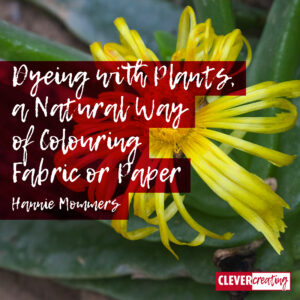
Botanical colouring, natural colouring, or plant colouring are different names for dyeing with plants. All with the objective of having a toxic-free or almost toxic-free dyeing process.
When I was a ceramicist, I was very interested in the way colours are produced.
I made my own coloured slips for years and when I wrote my article about the different colours of clay my interest in natural colouring, in general, was aroused once again.
Another reason was the colouring of Easter eggs. I wanted to do that in such a way that the eggshells could go on the compost heap afterwards without any problem for the environment.
Some of the links are affiliate links. As an affiliate associate, I earn a small commission when you purchase any of the products offered through the shared links at no extra cost to you. This helps me to maintain this website and I thank you for supporting me.
Table of Contents
Dyeing with plants is fun
All kinds of plants can be used for colouring your fabric or paper. Sometimes you have to add nothing more than vinegar or salt for lasting colours. Other times there have to be added some more products.
Colours from your garden
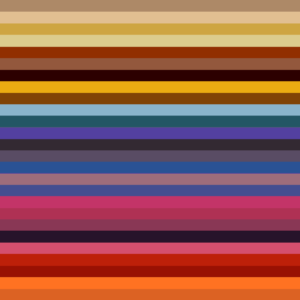
Generally, when thinking of gardening, one will think of flowers for beauty and vegetables to eat.
But wouldn’t it be fantastic to see vegetation as a way to make your own colours?
I can hardly garden myself anymore because of a back problem and still, there are several possibilities for me to grow plants for the dyeing process.
When I was living in the Netherlands (I live in Spain now) there was a public herb garden close by in my village with a tremendous explanation about all the features of plants. This has been a great help in my discovery of their potential.
Related: 8 Fun Ways to Decorate Easter Eggs for Ornaments or Egg Hunts
Textile colouring

Until 1850 the only way to dye fabric was by using plants. The old textile workers didn’t write their recipes down because of the competition, which is a pity of course.
Nowadays renewed attention to handmade and old-fashioned crafts created a revival and reinventing of the tested recipes.
If you want to use your own garden for dyeing plants you can make two choices:
- You choose only plants that will give the colours you are after;
- You plant flowers that will give you joy the whole summer because of their flowers and can be used as colouring plants as a bonus gift.
You can make almost every colour with plants, except the really bright artificial ones and neon colours. The colours will always have a natural character.

Plants that are for human consumption, generally don’t give long-lasting colours. Excellent for Easter eggs and other short-termed projects.
Related: How to Attract Insects to our Garden and Support Biodiversity?
Parts of the plants you can use
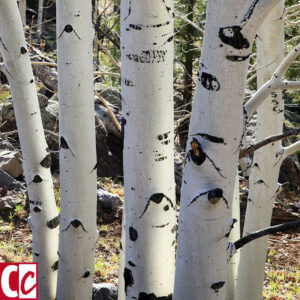
The useable parts of plants for dyeing are the roots, leaves, flowers, or bark. The various parts all give either a different shade or a completely different colour. Not all parts result in colours that last long.
Apart from plants, you can use wood, lichens, or fungi.
Some plants will give you a clue upfront about what colour to expect from them. For instance, berries or beets provide a red tone. But for a lot of plants, you’ll have to experiment to find out what the resulting colour is.

In the old ‘Dye it Yourself’-books a general tip is not to pick plants that grow near highways, because of the lead.
Most petrol doesn’t have lead anymore, but it might still be good advice. We did a course “Food from Wild Plants” the other day and the guide’s recommended distance was 50-100 m. from quiet roads and over 300 m. from a highway.
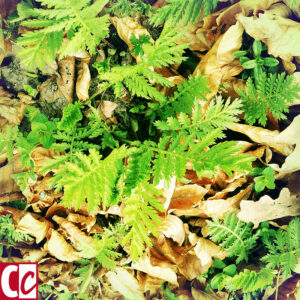
Several conditions will influence the colour
- Kind of plants;
- Parts of plants;
- The percentage used in regard to the fabric;
- Gathering place;
- Fresh or dried plants;
- Soaked or not;
- Boiled or not;
- Time of dyeing;
- Season of gathering;
- Mordant (take into account that several mordants are poisonous!);
- Developer;
- Temperature;
- Cooling down in the dye bath or out of it.
A direction, not a manual
What I share here are just a few guidelines. I am a strong supporter of experimenting, so I won’t give you a lot of recipes. Well, not only because of the experiments but also because I haven’t done this enough to be precise about the outcome. 😉
- Cut the material into the smallest pieces possible;
- If the material is soft (like leaves), soaking a night in cold water will suffice;
- Firmer material, like birch, is best soaked first and then boiled for an hour;
- Don’t wrap the dyeing material, make sure it’s loose in the kettle.

Natural colouring is mainly for animal products like wool and silk. It is possible to colour vegetal products like cotton and paper, but the colours will look faded.
An example of a recipe for yellow
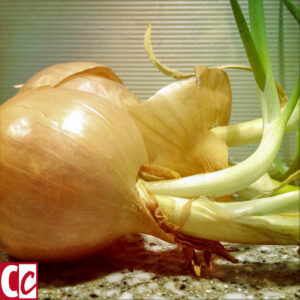
Ingredients:
- 100 % Fabric (this can be a t-shirt, a pillowcase, or sheep wool);
- 400% Onion skins (400 gr on every 100 gr of fabric);
- 20% Alum mordant (ask your drugstore or craft store).
Use enough water – the fabric must be able to ‘swim’.
Preparation of the mordant:
- Use a kettle or pan of stainless steel or enamel;
- Solve the alum in hot water (20 gr on each 100 gr of fabric);
- Put it in hot water of 80 to 90 degrees C;
- Wet the fabric and stir it in the mordant bath for half an hour at 90 degrees C, don’t let it boil.
Preparation of the dyeing plants:

- Put it in a pan and boil it like a soup;
- Either let it simmer on the fire for an hour or put it to rest for a night;
- Sift it.
Dyeing:
- Mix the dye and the fabric and heat up to 90 degrees C;
- Let it brew for 45 to 60 minutes.
Finishing:
- Cool the material down either in or out of the kettle;
- Rinse two times in lukewarm water with vinegar to fix the colour;
- Rinse more until the material no longer sends off colour;
- Dry.
Addition from someone on another platform

I like the article but if you use metal salts as a mordant they can be hazardous to your health (if you don’t take precautions) and aren’t really that great for the environment. Especially, if you dump it down the drain (it depends on what you use). I love indigo dyes but keeping a dye vat going can be very tricky.”
Have you used natural colouring? Tell me in the comment box below.
This article is an update. Originally published on 5-05-2013.


Tricky business this natural colouring. For your health, I mean. But given the fact that we have all got loads of unused masks, any toxic fumes shouldn’t be too much of a problem. You have to protect your skin and eyes also, I guess?
You have introduced three types of materials that can be dyed naturally: textile, paper and eggs. But can you also colour wood and stone with plant-based dye?
And I’ve another question. We have some very expensive stainless steel cooking pans. Perhaps these I better not use for dyeing? Because perhaps the acids corrode the pans?
Anyway, thank you again for an enlightening article. So cute …
Hi Richard, natural colouring doesn’t have to be hazardous to our health. It depends on the mordant you use. Some mordants are toxic, although the way they are toxic doesn’t always weigh heavy. So if you don’t feel comfortable using the toxic mordants, just use other ones. The colours will be different with the various mordants you use, yet will still be beautiful. There might be colours you won’t be able to make.
Stainless steel cooking pans are great to use. Yet, I wouldn’t be comfortable either if you also cook your food in those! Try to find ones in a second-hand shop or on the garbage belt you can use and dedicate those specifically to colouring. Enamel pans are great as well.
All in all, I think the toxicity is not as high as you fear.
Thanks for your comment and take care. 🙂